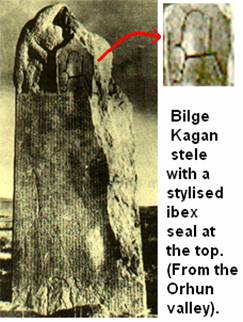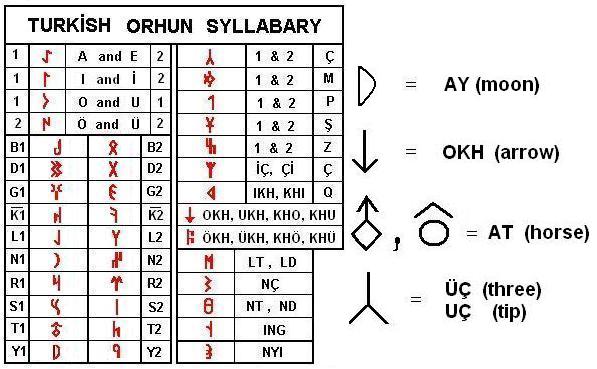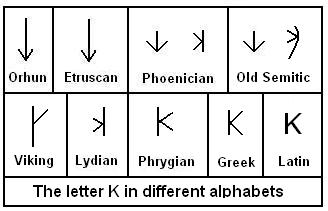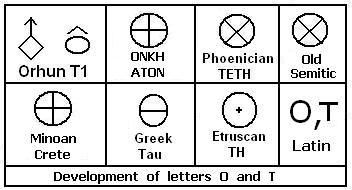|
The
Orhun Valley script is found on several inscribed steles of
Central Asia. Below we see the stele of Bilge Kagan (The wise
ruler) inscribed with Turkish “runic” characters. It is
claimed that this syllabary dates from the 8th
century AD. But such a sophisticated script, fully adapted to
transmit the ancient Turkish language, cannot start on the 8th
century AD. There are several other examples found in the
region belonging to earlier dates. As we examine this script
in detail we see that it contains many clues indicating its
close relationship to the ancient Proto-language of Central
Asia.

It was Vilhelm Thomsen (1842 –
1927) a Danish linguist, who first identified this script as
being ancient Turkish (1).
He published his decipherment in 1896 under the title
Inscriptions of Orchon Deciphered.
I am of the opinion that the correct name of the valley in
which these inscriptions were found is
Orhun and not
Orchon or
Orhon. This is because
“Or” means high and “Hun” is a well known Central Asiatic
nation that migrated towards the west. The Orhun syllabary
(below) has some special features which are not found in any
other script. Scholars call it the
Turkish runic script
because of its similarity to the Scandinavian runes. This
relationship, which is the consequence of the Hun expansion,
will be discussed in the future chapters. For the moment let
us concentrate on the Orhun syllabary
(2).
This script
contains 8 vowels separated in two groups, indicated with 1
and 2 in the Table below (see previous Chapters 20 and 2).
These groups were formed according to the sound harmony
inherent in the Turkish language. Because of the 38 characters
of the script we call it a syllabary and not an alphabet. The
syllabary contains special characters, such as ç
(tchea), þ (shea), yng,
ynch and
ynd that are specific
to Turkish. These characters are not later additions to the
script, as some scholars believe, but make part of the
syllabary from the very early start, which may be several
millennia BP.
The characters of this syllabary are specifically designed to
transmit the monosyllabic words of the Central Asiatic
Proto-language. Therefore, each character is a word and most
of these characters have a visual correspondence with the
meaning it represents, as shown below.

When
the T1 seal is read as at (horse) a symbolic
representation of a rider on a horse appears. We have already
seen that the Okh leader is an adult person carrying an arrow
and riding a horse. This symbolism of uniting rider and horse
has also a special meaning. It conveys the message that the
rider and his horse are fused together and should not be
separated at any cost, even after death.
The word
standing for “arrow” in Turkish is ok, as mentioned on
several occasions before. As soon as humans started hunting
they developed first the spear and then the bow and arrow.
Considering this fact we can safely assume that the
T1 and the
OKH character were
among the earliest signs of the pictographic writing system.
They appeared first on the seals of the Proto-language and
later on transgressed into several scripts, from the Central
Asiatic early Uighur script to several alphabets, to finally
end up in the Latin alphabet. The modern
K as well as the
O and the
T are transformed
forms of the T1 seal. Below we see how the arrow seal gave
rise to the Latin K.

The T1
seal can be pronounced not only as “At” but also as “Ot” (sun
or fire) and “On” (venerable, important). We have seen in
Chapter 6 several examples of the
Onkh seal. Considering
that the words for horse (at) and ancestor (ata) stem from the
same origin, it is not difficult to see that the fusion of
ata with
on give Ata-On or
Aton
the sun-god of the Egyptians during the reign of
Akhenaton
(3).
This pharaoh name seems to be made out of syllables
originating from the Central Asiatic Proto-language:
Okh-Han-Ata-On “The
universal Okh ancestor and leader”. More details on this name
will be elaborated in the next chapter. Below we see that
there were two versions of the T1 seal in the ancient script.
These forms have a close relationship to the
Onkh / Ankh seal which
eventually gave rise to the letters O and T (see Chapter 6,
The universal symbols).
 |